After finally getting the big Concorde to fly properly (details here) it was time for another challenge for the winter build project of 2012/2013.
In 2010 I was given a book called Concept Aircraft (ISBN 1-59223-480-1) which has lots of interesting and unusual models in it. The one that stood out for me was the Sanger. This is a design by Deutsche Aerospace for a two-stage re-usable aero-space plane. First stage is the carrier vehicle, on which a space shuttle is mounted which makes up the second stage. This is what it could look like :
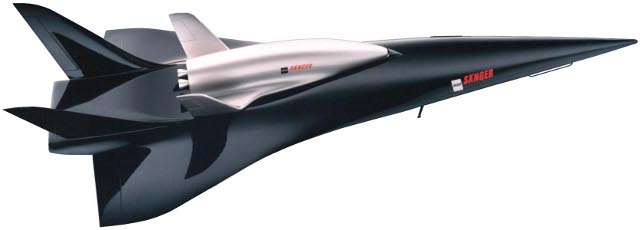 | Picture courtesy of Deutsche Aerospace |
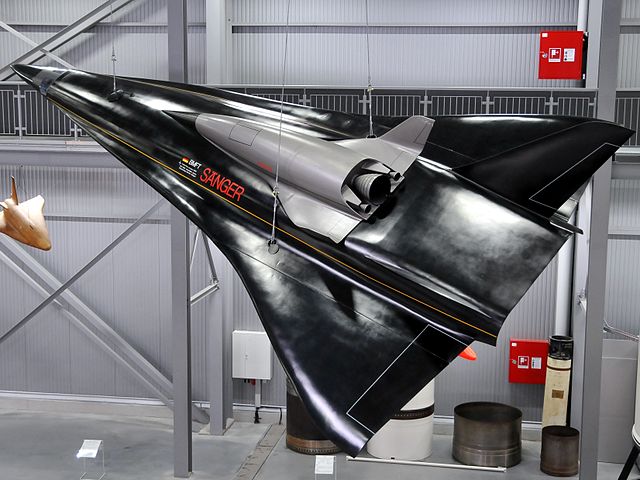 | This picture shows a mock-up of the Sanger in Technik Museum Speyer. Author of this pic : Palatinatian |
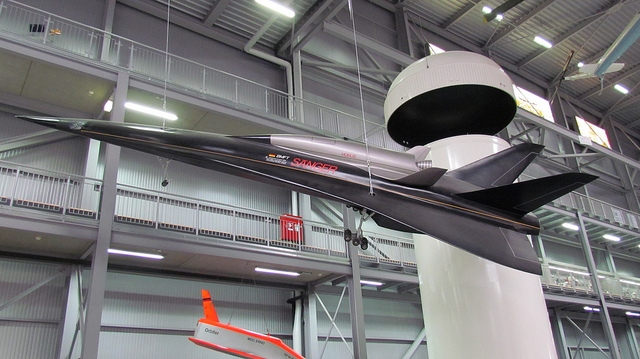 | Another view of the same mock-up |
1. Design outline
To power this vision of the future, I would like to re-use 2 of the 3 EDF units that I now have spare following the conversion of my big Concorde.This means we need 2x 3S 2200mAh LiPo batteries and that then brings the total weight of the electronics to around 455 gr.
The EDFs are expected to produce around 800 gr thrust in total; sticking with a comfortable 75% thrust-to-weight ratio means that all-up weight should be no more than 1066 gr, which then leaves 1066-455 = 611 gr airframe weight.
I estimate the total wing area for this shape to be : Length x 0.5 wingspan x 80%; with the Length being close to 2x wingspan that makes : wing area = 0.8 x (wingspan)square. Opting for a medium wing loading of 30 gr/dm2 means we need 35 dm2 of wing area, which translates to a minimum 66 cm wing span. The 6 mm depron sheets measure 70x100 cm so to make things easy we'll go for a 70 cm wingspan and therefore a 140 cm length, which means a wing loading of 1066/40 = 27 gr/dm2.
To summarise :
- All-up weight 1066 gr
- Length 140 cm, wingspan 70 cm
- Thrust 800 gr ; TTW ratio 75%
- Wing loading 27 gr/dm2 ; wing area 40 dm2
- Power 2 x 275 = 550W ; Power ratio 232 W/lb
To help with that, I am thinking of a main wing made from a single sheet of 6mm depron with tape reinforcements, and 3mm depron skins.
2. Prototyping
As there are no build plans available I am making my own plans. Using the various artist's inpressions and the mock-up above I created a simple plan that looks close enough to be convincing in the air, without being an exact copy.| To refine the plan I printed it and put the paper parts together to find out what was or wasn't correct. Then fixed the drawing, printed it again and rebuilt. Here is one of those paper models. | 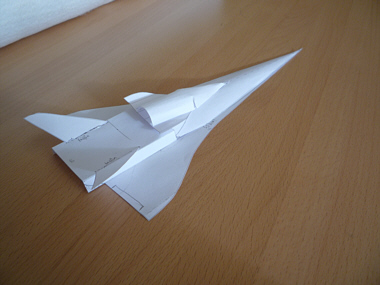 |
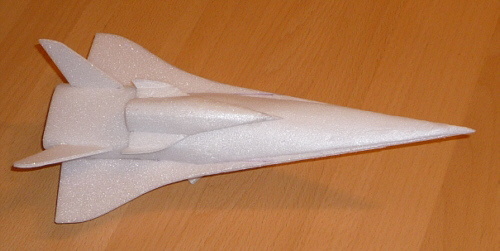 |
Once I was happy with that, I repeated the process with 3mm depron instead of paper. This was mostly to check that the depron material could be moulded to the required shapes. |
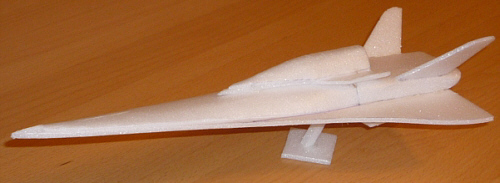 |
It can ! |
December 2012 - I used these little prototypes to work out where the Centre of Gravity (CoG) needed to be. Just a matter of adding some weight (a blob of blutac!), and adjusting its position until it glides nicely. Once done, transfer the actual CoG to the plans. |
|
11 Jan 2013 - finished final prototype of the the shuttle at approx 1/2 of its final size. Simplicity itself as it consists of only 3 pieces : wing, fuselage and the back plate that holds the rocket outlets. Those rocket nozzles are nothing more than some pieces of sheet metal from a coke can bent into shape. Total weight of this shuttle is 5 grammes. |
|
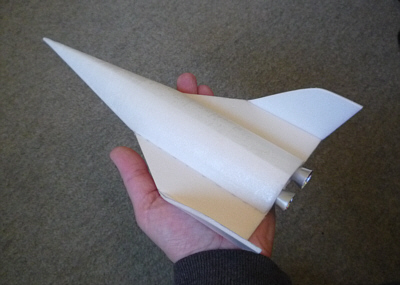 |
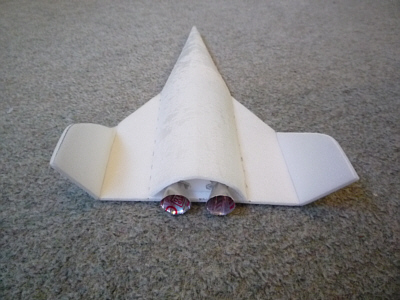 |
3. Building
| 20 Jan 2013 - Finished cutting out the depron at full (model) size today. The carrier is cut from 6 mm depron (8 pieces) and the shuttle is 3 mm
depron (2 pieces). Total depron weight shown here is 220 gr. The trainer is just there to give a size comparison ! |
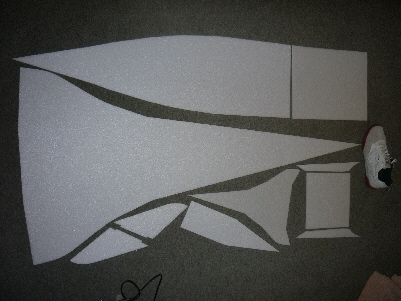 |
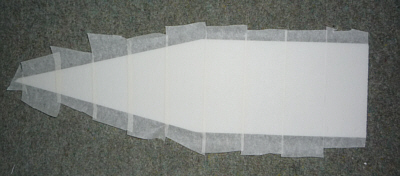 |
late Jan 2013 - Building the shuttle took about 1.5 hours. Here is the top bit before bending, covered with masking tape. The tape should be on the OUTSIDE to stop the depron from splitting during the bending process. |
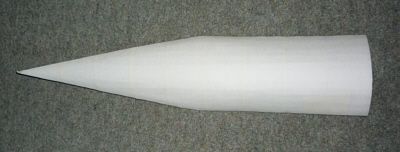 |
... and here is that same piece after bending it bit by bit over a table edge, and removing the tape afterwards. |
| And here is the finished result. Top, bottom, and depron backplate holding the rocket nozzles. All held together with a few lines of UHU POR glue and some hot melt glue for the nozzles. Total weight 14 gr. | 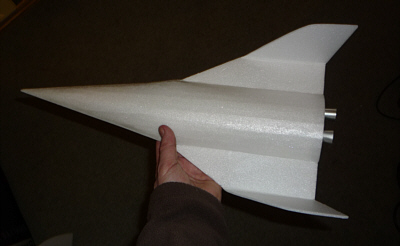 |
Feb 2013 - Started on the main carrier. Looking at the underside now, I added the sides of the engine bay, cut away a rectangular shape where the motors will sit, and bent the front lip ... | |
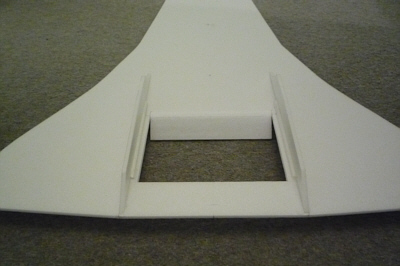 |
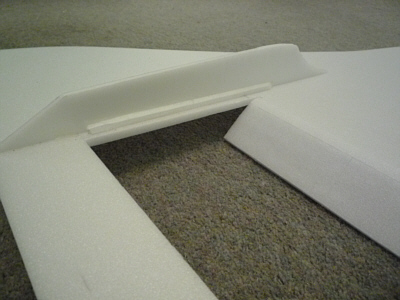 |
| Here is a view of approx. where the motors will be in the finished product (still looking at the underside of the plane here). | 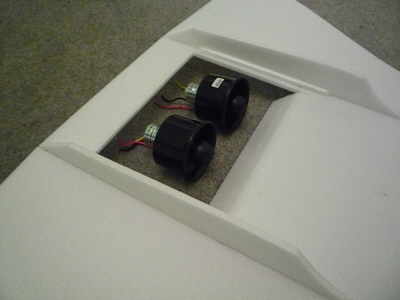 |
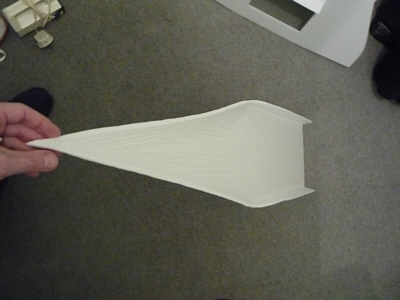 |
This is what the inside of the top of the fuselage looks like just after bending. You can see the lines I put in there (with the back of a small brush) to control where the depron was bending. Quite a complex shape, as the front is quite rounded but the back is flat. |
After glueing the fuselage top to the main wing this is what it looks like from top (on the left) and bottom (on the right). I've also glued the bottom of the engine bay on, to work out how to fit the motors. I've decided to follow the same method that held these same motors in the Concorde originally. The motors are just a loose fit at this point. |
|
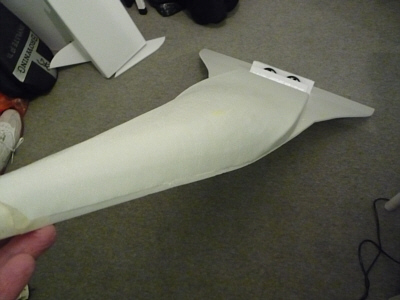 |
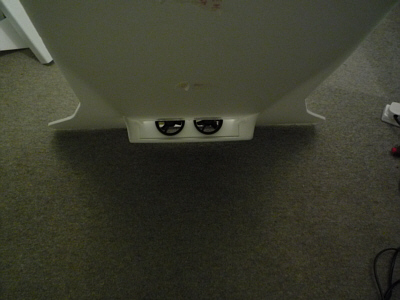 |
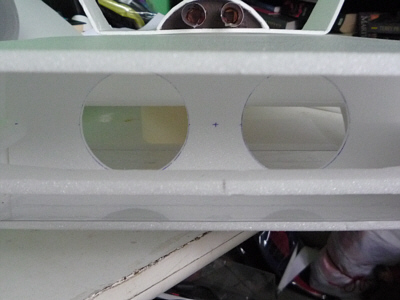 |
View from behind the plane. I have lined the outlet (near the bottom) with a sheet of acetate to make the surface as
smooth as possible; very important for improving the efficiency of the EDFs, and one of the lessons learnt from my experiments with the big Concorde.
I also put the little shuttle on top for effect :) |
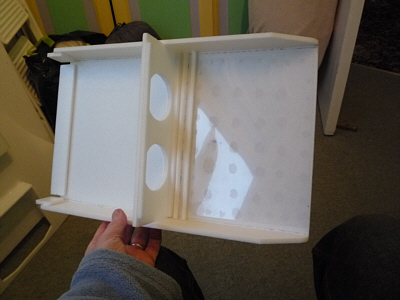 |
As the plane is 140cm long and the depron sheet is only 100cm long there had to be a join somewhere. On the main wing that join is near the front,
so on the fuselage it had to be somewhere else to prevent the joins aligning (and creating a structural weak point). On the fuselage the join is
at the back and that's what I call the deck. Conveniently that now gives us a separate cover for the engine area and that's what is shown here. It
will sit on top of the plane at the back. The right half is lined with an acetate sheet as well. Part of the left half is still to be lined. I made slots for the depron plates holding the EDFs so that this cover can be taken off later without too much damage. Those EDF plates will be glued in at the bottom though. |
| Here is some detail about those plates and how the EDFs are fitted to them. A single sheet of 6mm depron, with holes the same size as the EDF casing so it is a good fit (approx 58mm diameter for these EDF55's) | 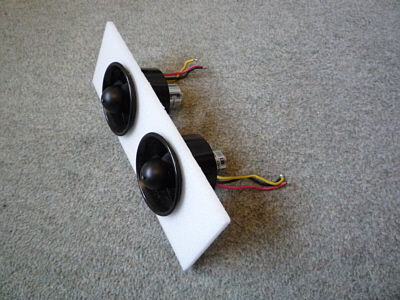 |
| Next I worked in some glue (aliphatic resin) between the casings and the depron. Leave to dry in this position, so gravity helps to keep the glue
in the join. The front of the fan is at the bottom here (underneath the depron). |
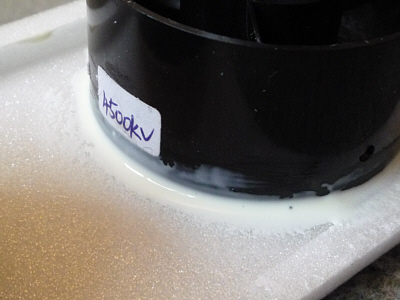 |
| After that first set of glue has dried, 4 spacers each are glued to the casings. These are a safety precaution : should the EDF
work itself loose from the plate, then these spacers will stop the EDF from pulling itself out of the plates. Next a second plate is added and glued in the same way as the first plate. Then it's just a matter of finding a way to let the glue dry whilst everything is supported and straight and held in place ! |
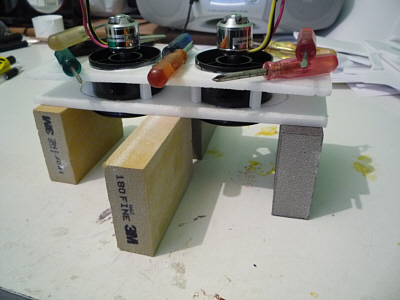 |
While that was all drying I carried on with the electronics. It's a pretty straightforward setup :
|
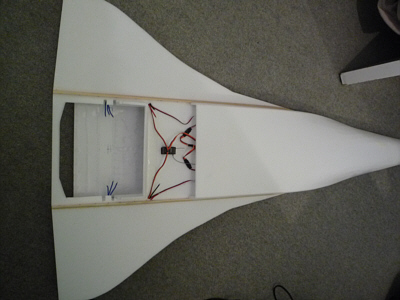 |
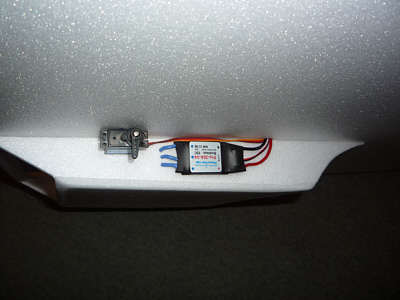 |
Close-up of the ESC and servo mounted on the side of the air scoop. The servo is not connected to the control surface yet, that will come later. |
| Those blue wires are coming from the ESC and need to be soldered to the other 3 wires which are going to the motor. VERY little room to work in, with a hot soldering iron that melts depron from a distance... This is probably the trickiest bit of the entire build. I used plain paper to shield the depron from some of that heat and got away with minor damage that is not visible from the outside. |
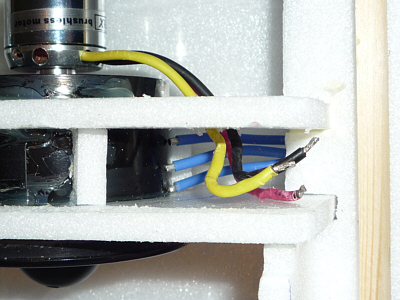 |
| The motors are in place and some of the soldering is done. | 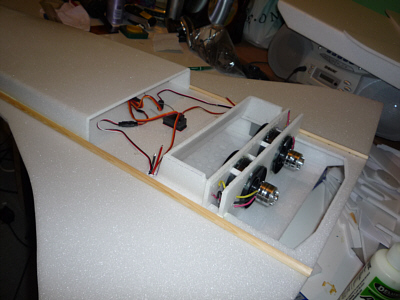 |
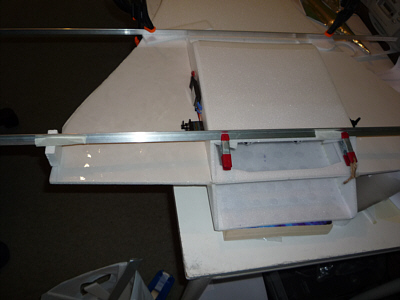 |
With the extra weight of the motors now in place I noticed that there was a fair bit of flex in the wings at the back. To make that more rigid,
with little weight gain, I lined the underside of the wings with some plain printer paper, attached with some diluted PVA glue. You can still see
it shine on the left where it's wet. As the water evaporates, most of the extra weight disappears and the paper shrinks, which gives the rigidity. As I'm only lining one side of the wing, there is a risk that the shrinkage makes it bend; to prevent that I attached some of my aluminium profiles which will keep the wing straight while its drying. |
All the wiring is in place now, secured with some dollops of hot melt glue :
|
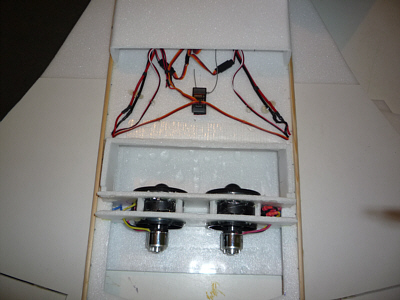 |
| The deck/engine cover is in place and I've added some decals, including some windows left over from the Airbus A380 build! I've also cut out the ailerons, angled instead of straight, just because I think it looks better. They are also connected to the servos now. You can just about see that I have added paper to the top of the wing as well (PVA glue soaked as before). |
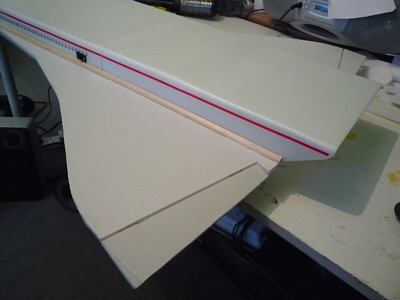 |
| Decorations finished (including the Dutch flag of course) and tail fins added it was time for a photo shoot ! The shuttle is just standing on top, not fixed yet. I will fix it once I know the carrier is flying successfully. |
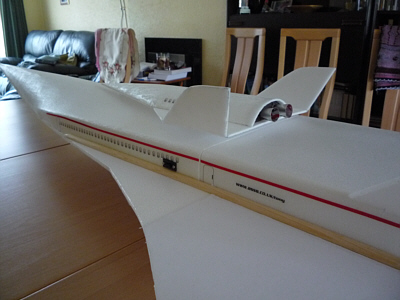 |
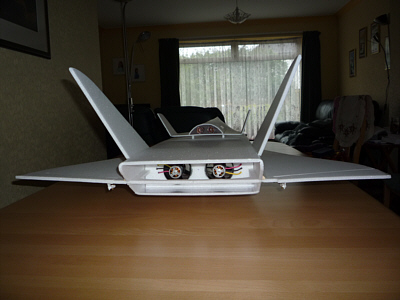 |
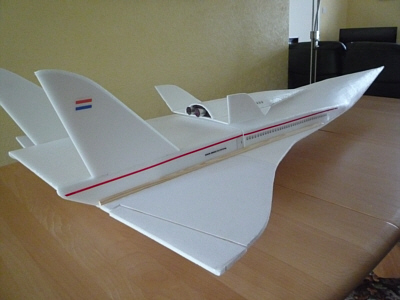 |
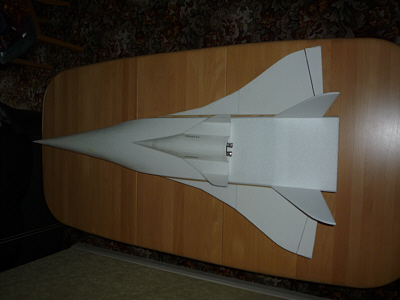 |
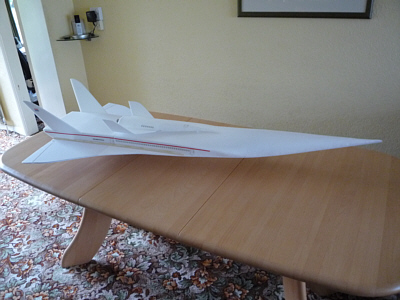 |
How about this one, pretty cool : |
|
 |
|
Now that we know where the batteries need to go (in order to get the CoG in the right place) it's time to give them a nice secure home. This is big enough to hold 2 x 3S 2200 mAh LiPo batteries (one for each motor). The plane is upside down in these pictures, so in flight the batteries will be hanging from the top of the fuselage. I did add a 2nd velcro loop later, plus I glued some velcro on the liteply to grip the velcro already attached to the batteries. |
|
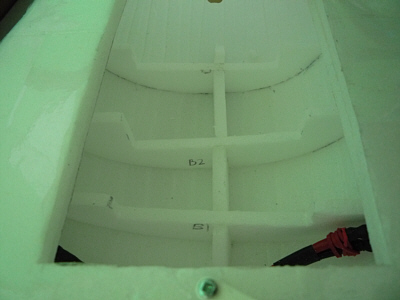 |
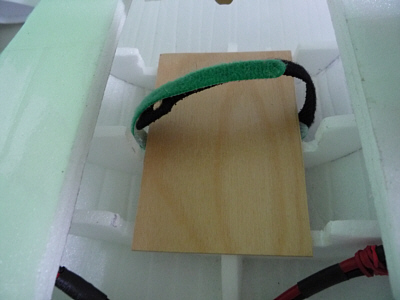 |
| Power switch on the side of the fuselage. It controls the power from the ESC to the receiver, which in turn controls the servos and ESC. | 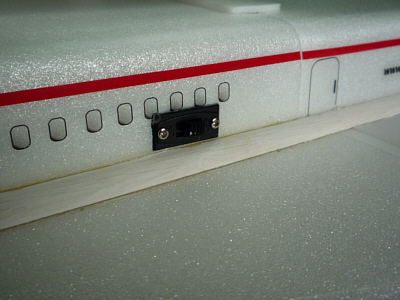 |
| Some more decals added. These are waterslide decals. Simply create your own design on a PC, print it out on these sheets, seal it with some spray
varnish and fix on the plane. Works a treat every time. The red line comes ready made on a small roll, from Halfords (car accessories). |
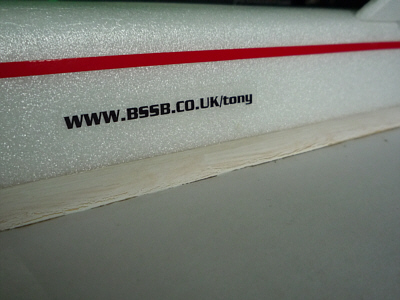 |
| I cut the remaining cross-section at the back as well, to give the EDFs a clear outlet. Top and bottom of the outlet are lined with acetate sheet for a supersmooth surface. |
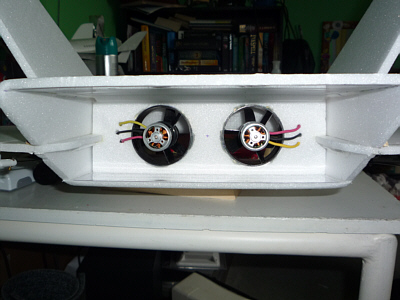 |
| View of finished back section. Servos are connected to the ailerons. Covering is with ordinary sticky back plastic. | 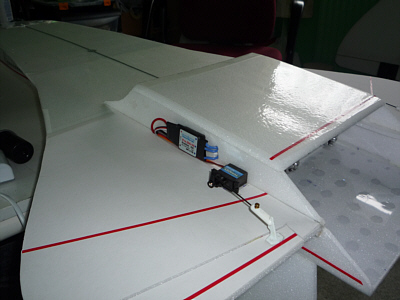 |
| That sharp nose made from depron is far too fragile. Just a little cap that I had lying around. |
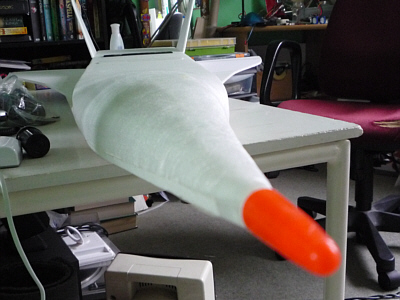 |
4. Getting ready for the first flight
Time to fire up those motors again and measure what this inlet shape has done to the efficiency of the EDF propulsion ! Total inlet area to the motors is 4x23 cm = 92 cm2; this is the overall inlet area in the pictures below. FSA ('Fan Swept Area' - the total effective surface area covered) is 18.9 cm2 per motor, which is just under 38 cm2 total. This is the overall outlet area of the motors. So the overall inlet area is almost 2.5 times as big as the overall outlet area so in theory the motors have more than ample air supply. In practice things are a bit different though... At approx 45,000 RPM the tips of the fans in the EDFs are doing around 122.5 meter/sec, which is around 274 mph (!). The fan is approx 10 mm wide at the tip, and over that 10 mm it pushes the air back approx 7.5 mm. This means it is trying to push the air back at around 200 mph. However air is compressible, and friction and turbulence cause havoc, so it may be doing 'only' 100 mph coming out of the back of the EDFs. Still, it illustrates that air must therefore be sucked into the inlet at a great speed as well. Looking at the unfinished inlet (picture below left) this is not exactly an aerodynamically efficient shape, as it has sharp corners, rough surfaces and an inlet that is not pointing directly at the EDFs. Only the bottom half of the fans is pointing directly at the inlet. I measured the thrust at this stage, and total thrust was only 385 gr, or 192 gr per motor. Well short of the 425 gr per motor that I achieved on the big Concorde with those same EDFs and motors. Just like with the Concorde, my first action was to make the inlet more efficient. I lined the inlet with 3 mm depron to give a smooth curve into the EDFs, and then I lined that with some clear acetate sheet (as used on the old overhead projectors) to give it a supersmooth surface. End result of that is shown below right. |
|
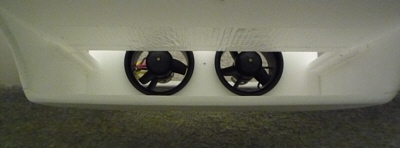 |
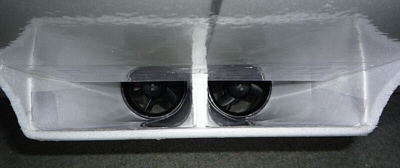 |
| Result of this was that total thust went up from 385 gr to 465 gr, an improvement of 20%. I had expected more, but that's what it
was. It struck me that actual thrust was about half of what should be possible, and about half of the fans had clear sight of the inlet. As if those top halves of the EDFs were not contributing anything to the total thrust. Coincidence ? |
|
| A solution to this would be to try and feed in some extra air from above the plane to those top halves of the EDFs. To check out the impact without changing
the look of the plane I added what's called a 'cheater hole'. I cut out a slot just above/in front of the EDFs and covered it with a plastic grille. Result ? Total thrust up from 465 gr to 660 gr, a 42% increase. Or 77% of the maximum achievable. There is further scope for improvement here, as the 'holes' in that grille only add up to about 9 cm2. This could be increased 2-3 fold which should give some further increase in thrust. |
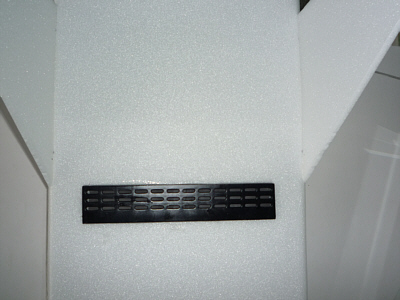 |
| Thrust-to-weight ratio (TTW) at this stage is 660/1095 = 60%. This is the same ratio at which my big Concorde started flying (although only just).
When holding the plane horizontal at full thrust it does feel more than adequately powered, so I've decided to do the maiden flight as is, and leave the option of further increasing the cheater hole as a plan B. In the mean time here is a 360 degree video of the Sanger on the ground. |
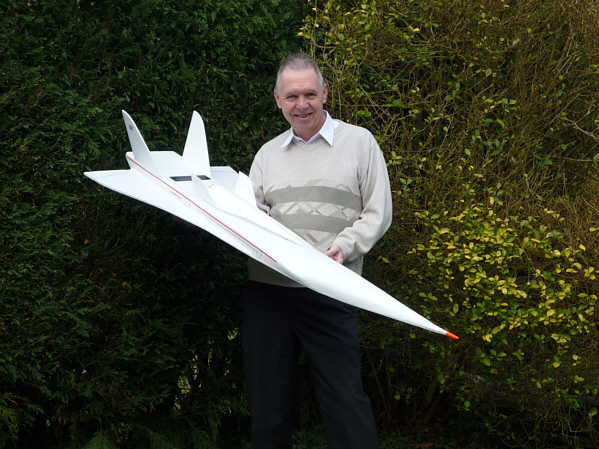 |
5. First flight attempt
On 3rd May 2013 finally the conditions were right and I took the Sanger out to a local field (with long grass for soft landings !) to have a go. First hand launch was on full throttle with around 20 degree up angle. CoG is pretty much accurate as there was no nose up/nose down tendency. Good response to ailerons. However.....just as with the early Concorde attempts all it could manage was a long glide of 50 - 60 meters. Even on full throttle there was insufficient thrust to gain height. Two more launches followed, all with the same result, so it's back to to the workbench to see how we can squeeze out that last 23% of thrust that's still in there somewhere....6. Hunt for more thrust
| First I took off the black grille over the cheater hole. Surprisingly this made no noticable difference. Next I added a short outlet tube to one of the motors.This one is plain straight, approx 6 cm long, see picture. Previously we had approx 660 gr thrust in total, or 330 gr per motor. Adding that outlet tube increased the thrust marginally to 350gr (6%). |
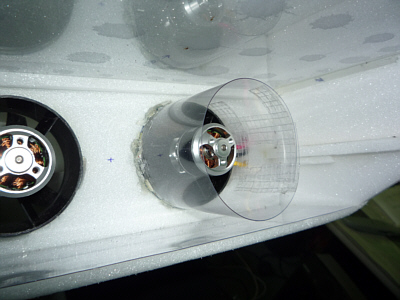 |
| Next it was time to see the effect of adding an inlet tube as well. First I experimented for a while with a tube from acetate sheet with an oval inlet and a circular outlet but could not get that to fit properly. Time for drastic action. I decided to try and fit a solid straight tube and cut away as much depron as was needed to fit that in. Not elegant but it would at least give me the answer whether or not EDF could ever produce sufficient thrust in this setup. I found that an old badminton shuttlecock tube has (almost) the perfect diameter for the EDF55 duct so I 'hacked' that into place, see pics below. It is approx 18 cm long at this stage. |
|
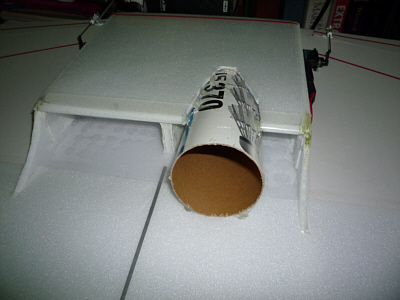 |
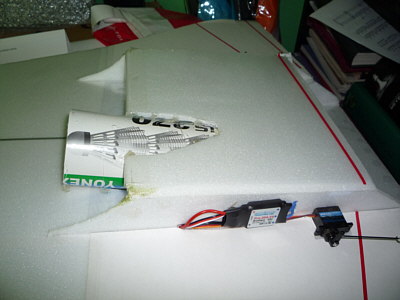 |
| Once this was securely in place it was time for another test. I slowly revved up the one motor and the tube held up well. Result ? Thrust is up from 350gr to 430gr (23%) for a single motor which is an excellent result. There is now more thrust from that single motor than there was from both motors combined at the first setup ! Clearly the inlet tube has the biggest influence on static thrust. If I can get both motors to run at this efficiency then the thrust-to-weight ratio will end up around 75% which is right on target and more than I ever managed with the big Concorde on EDF. Looking promising.... Onwards, the second tube was fitted and then I trimmed the front of the tubes to match the sides of the air scoop. I did not like the look of that so I covered it with a bit of depron and then carefully cut out the holes to match the tubes. |
|
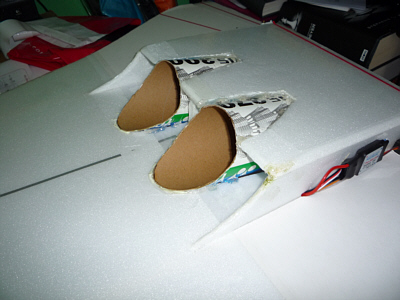 |
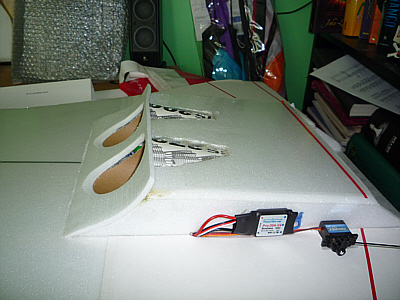 |
| To finish off I made a nice wavey bit of depron to go over the top so the tubes are now completely hidden. This should also give a bit of extra strength for landings as the air scoop is the lowest point of the plane so will touch the ground first. As shown by the green patch on the right top corner of the air scoop, which is from a landing on grass...... Finally I added the second outlet tube at the back. All done ! | |
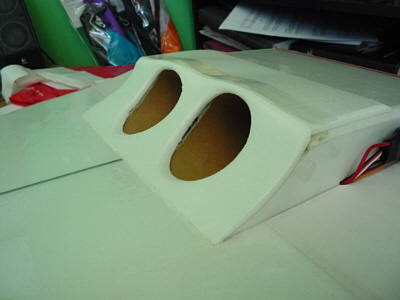 |
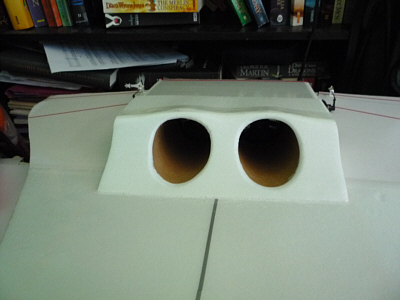 |
| Time for some more measurements : all-up weight has increased slightly from 1095 to 1160 gr. Total thrust (2 engines) has gone up to 940 gr, or 470 gr/engine which is excellent. This makes for a 940/1160 = 81% thrust-to-weight ratio, slightly better than the intended 75%. Wing loading is 1160/40 = 29 gr/dm2, slightly worse than the intended 27 gr/dm2, as is the power-to-weight ratio at 213 W/lb compared to the intended 232 W/lb . Overall still a decent set up so I am pretty confident this will now fly. It may be mid June at the time of writing this bit, but it is blowing a gale outside so it may yet be a few weeks before I can report on the second flight attempt. |
|
7. Flying
29 June 2013 - finally, time for another go at a local field.Here is the video. First attempt was just another slow glide down to the ground. Judging by the sound on the video I did not have the throttle fully open. Second attempt was a slow climb out (!) following by a right turn which turned out to be too sharp to maintain altitude so she came down into the long grass. One of the elevators became unstuck plus the batteries moved and caused some fuselage damage. Easily fixable so still a success I think. Next flight will be on Chobham common with lots of room for a long climb out and wide turns.
6 July 2013 - Finally time to fly at Chobham ! Very warm and with a steady breeze. I was struggling to launch the Sanger on my own, but luckily another flyer offered to do the honours so that was a great help. On full throttle and at a shallow angle she dipped slightly before gaining height. Beautiful. What a sight to see this thing actually fly. It was quite a handful though: the breeze was stronger than I had assumed, the elevon rates were set too high, and on top of that Sanger does lose height very quickly when banking too steeply. During the second circuit I briefly lost control of her because at a distance it is so difficult to see what's what. In the end I did 3 full circuits before landing. The glide was slightly shorter than expected, whch meant she landed on solid ground, just 2 feet short of the cushioning heather bushes that I was aiming for. As a result the batteries moved forward and caused some damage to the underside. Minor damage but sufficient for me to call an end to the test flying and move on to flying one of my other planes.
Since then I have :
- glued a sturdy end-stop into the battery compartment and added an extra velcro strap to better secure the batteries
- reduced the elevon controls by adding a lot of exponential on the transmitter
- improved visibility by adding some bright green stripes to the bottom of the plane
Comments ? Suggestions ? Requests ? Email me on :
